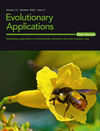
More Press Releases in: |
Media ToolkitContact Publicity to:
|
First Study into Reproduction of GM Atlantic Salmon Reveals Danger of Escape to Wild Gene Pool
If genetically modified Atlantic salmon were to escape from captivity they could succeed in breeding and passing their genes into the wild, Canadian researchers have found. Their research, published in Evolutionary Applications, explores the potential reproductive implications of GM salmon as they are considered for commercial farming.
“The use of growth-enhancing transgenic technologies has long been of interest to the aquaculture industry and now genetically modified Atlantic salmon is one of the first species to be considered for commercial farming. Yet, little is known about the potential impact on wild salmon populations if the GM species were to escape captivity,” said lead author Darek Moreau from the Memorial University of Newfoundland, Canada.
One of the key concerns about a transgene escape is the “Trojan gene effect”, caused when a GM fish outcompetes or reproduces equally against wild rivals, however if the resulting offspring are genetically inferior this could lead a species towards eventual extinction. Until now there is no empirical research to demonstrate the ability of transgenic Atlantic salmon to breed naturally and infiltrate the wild gene pool.
In the wild, reproducing males present two main forms of rivals which any escaping transgenic male would have to compete with; large males which have migrated and returned from the sea and smaller male parr which have matured in freshwater. The large males are aggressive and develop attributes to fight off their rivals, while the smaller male parr use cryptic colouring and ‘sneak fertilisation’ to compete.
To measure the ability of transgenic males to complete with wild males during the reproductive season the team monitored breeding behaviour in a naturalised laboratory setting and used genetic analysis to determine the success of competing individuals at producing offspring.
Large, migratory wild males outperformed their captivity-reared transgenic counterparts in terms of a variety of spawning behaviours. Moreover, despite being less aggressive, non-transgenic male parr were also able to outperform their GM rivals in terms of spawning behaviour, and as a result, achieved higher overall fertilisation success.
“While the transgenic males displayed reduced breeding performance relative to their non-transgenic rivals they still demonstrated the ability to successfully participate in natural spawning events and thus have the potential to contribute modified genes to wild populations,” said Moreau.
While the study provides an estimate of breeding performance under only a single set of physical and demographic environmental conditions, it does mimic a likely invasion scenario where the genetic background of the transgenic population differs from that of the wild population.
“Our study provides the first empirical observations on the natural reproductive capacities of growth hormone transgenic Atlantic salmon,” concluded Moreau. “While the resulting ecological and genetic effects of a transgene escape remain uncertain, these data highlight the importance of preventing reproductively-viable GM salmon from entering natural systems.”


